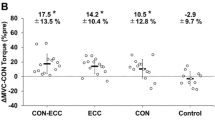Summary
The purpose of this study was to investigate the force-producing characteristics of boys aged 13 years in relation to fatigue of elbow flexor muscles. Maximal voluntary force in elbow flexion was measured before and after a muscle endurance test (MET) by using an isokinetic dynamometer isometrically, concentrically and eccentrically at three velocities, i.e. 0.21, 0.52, and 1.05 rad · s−1. The MET consisted of maximal concentric and eccentric muscle actions performed alternately at 0.52 rad · s−1 for 50 consecutive trials. Muscle cross-sectional area (CSA) of elbow flexor muscles (biceps brachii and brachialis) was measured by a B-mode ultrasound apparatus. Although eccentric force showed significantly higher values than concentric force during MET, there was no significant difference in the rate of decline in force between the two actions. There was no significant difference in the rate of decline in force after MET for each velocity and muscle action. Isometric, concentric and eccentric force before MET was significantly related to muscle CSA whereas, after MET, concentric force significantly correlated with muscle CSA but there was no significant correlation between muscle CSA and isometric or eccentric force. From our study, it is therefore suggested that in development to maturity, isometric, concentric and eccentric force decrease at the same rate with advancing muscle fatigue; however, there might be differences among muscle actions in facors affecting force development.
Similar content being viewed by others
References
Alway SE, Stray-Gunderson J, Grumbt WH, Gonya J (1990) Muscle cross-sectional area and torque in resistance-trained subjects. Eur J Appl Physiol 66:86–90
Asmussen E, Heeboll-Nielsen KR (1954) A dimensional analysis of physical performance and growth in boys. J Appl Physiol 7:593–603
Asmussen E, Heeboll-Nielsen KR (1955) Physical performance and growth in children. Influence of sex, age and intelligence. J Appl Physiol 8:371–380
Atomi Y, Fukunaga T, Hatta H, Yamamoto Y (1987) Relationship between lactate threshold during running and relative gastrocnemius area. J Appl Physiol 63:2343–2347
Colliander EB, Tesch PA (1987) Effects of acute concentric and eccentric exercise on rate of force recovery. Med Sci Sport Exerc 19:S36
Hageman P, Gillasoie D, Hill L (1988) Effect of speed and limb dominance on eccentric and concentric isokinetic testing of the knee. J Orthop Sports Phys Ther 10:59–65
Hortobagyi T, Katch FI (1990) Eccentric and concentric torque-velocity relationships during arm flexion and extension. Eur J Appl Physiol 60:395–401
Ikai M, Fukunaga T (1968) Calculation of muscle strength per unit cross-sectional area of human muscle by means of ultrasonic measurements. Int Z Angew Physiol 26:26–32
Kawakami Y, Fukunaga T, Kanehisa H, Miyashita M (1989) Some factors affecting eccentric contraction strength. J Biomech 22:1034
Kawakami Y, Hirano Y, Miyashita M, Fukunaga T (1993) Effect of leg extension training on concentric and eccentric strength of quadriceps femoris muscles. Scand J Med Sci Sports 3:22–27
Komi PV (1973) Measurement of the force-velocity relationship in human muscle under concentric and eccentric contraction. Med Sport (Basel) 8:224–229
Komi PV, Viitasalo JT (1977) Changes in motor unit activity and metabolism in human skeletal muscle during and after eccentric and concentric contraction. Acta Physiol Scand 100:246–254
Maughan RJ, Nimmo MA (1984) The influence of variations in muscle fibre composition on muscle strength and cross-sectional area in untrained males. J Physiol 351:299–311
Maughan RJ, Watson JSD, Weir J (1983) Strength and cross-sectional area of human skeletal muscle. J Physiol 338:37–49
Nygaard E, Houston M, Suzuki Y, Jorgensen K, Saltin B (1983) Morphology of the brachial biceps muscle and elbow flexion in man. Acta Physiol Scand 117:287–292
Sale DG, MacDougall JD, Alway SE, Sutton JR (1987) Voluntary strength and muscle characteristics in untrained men and women and male body-builders. J Appl Physiol 62:1786–1793
Shantz P, Randall-Fox E, Hutchinson W, Tyden A, Astrand PO (1987) Muscle fiber distribution, muscle cross-sectional area and maximal voluntary strength in humans. J Appl Physiol 62:1786–1793
Tesch PA, Dudley GA, Duvoisin MR, Hather BM, Harris RT (1990) Force and EMG signal patterns during repeated bouts of concentric or eccentric muscle actions. Acta Physiol Scand 138:263–271
Tredinnick T, Duncan P (1988) Reliability of measurements of concentric and eccentric isokinetic loading. Phys Ther 68:656–659
Weltman A, Janney C, Rians CB, Strand K, Berg B, Tippitt S, Wise J, Cahill BR, Katch FI (1986) The effects of hydraulic resistance strength training in pre-pubertal males. Med Sci Sports 18:629–638
Westing S, Seger J, Thorstensson A (1988) Does neural inhibition suppress eccentric knee extension torque in man? Med Sci Sports Exerc 21:S67
Westing SH, Seger JY, Karlson E, Ekblom B (1990) Eccentric and concentric torque-velocity characteristics of the quadriceps femoris in man. Eur J Appl Physiol 58:100–104
Author information
Authors and Affiliations
Rights and permissions
About this article
Cite this article
Kawakami, Y., Kanehisa, H., Ikegawa, S. et al. Concentric and eccentric muscle strength before, during and after fatigue in 13 year-old boys. Europ. J. Appl. Physiol. 67, 121–124 (1993). https://doi.org/10.1007/BF00376654
Accepted:
Issue Date:
DOI: https://doi.org/10.1007/BF00376654




